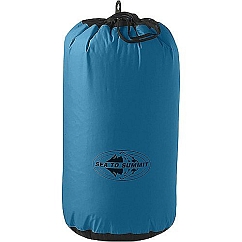|
 | |  |
| LOWER MAIN COMPARTMENT | |
| For some reason, some people will tell you that the lower main compartment of an external frame pack is where you store your sleeping bag. While I suppose you could store it in there, I prefer to put my sleeping bag in a stuff sack and strap it to the bottom of the pack (see "bottom roll"). Instead, I used the lower main compartment as a place to keep my clothing. At some point, I may add a chapter to this website with advice on what clothing to consider packing.
| |
| Stuff Sack for Clothing
| |
|

|
|
In a stuff sack large enough to fill the lower main compartment, I put whatever clothes I think are most appropriate for the trip. I put the least needed items at the bottom of the stuff sack, and the most needed ones at the top for easy access. At night, I use this stuff sack with the clothing in it as a pillow. A good stuff sack is usually made of nylon, has a drawstring, is reasonably water reseistant, and has a flap near the opening to cover the contents when cinched closed. There are many good brands of stuff sacks available. The one shown here is a Sea to Summit stuff sack.
|
|
| Sleeping Bag Liner
| |
|

|
|
Generally speaking, this item is intended to go inside your sleeping bag to make it a little warmer, and perhaps a little more compfortable. I suppose you could think of it like a sheet you would put on your bed at home. Some products claim that they can add about 10 degrees of warmth to the temperature rating of your sleeping bag. In Texas, however, and other places where camping is more likely to occur in hot weather, this item can be considered an alternative to a sleeping bag althogether. Quality and prices for sleeping bag liners vary dramatically depending on what they are made of. Synthetic ones can be had for about $10, while silk ones can cost over $50. Mine is a silk, mummy shaped liner by Coccoon like the one shown here.
|
|
 | |  |
|









